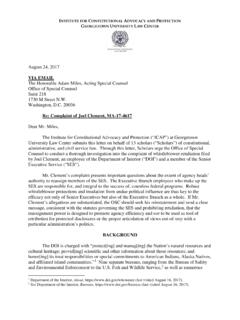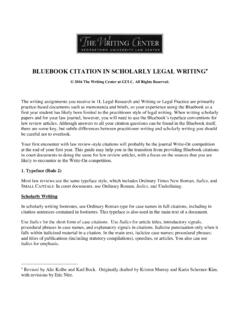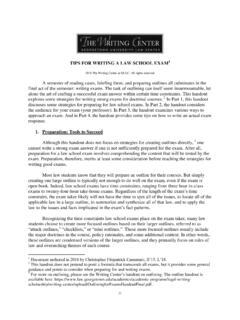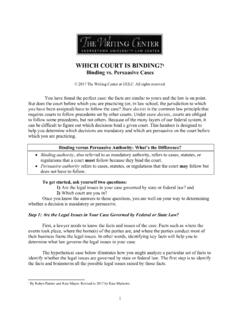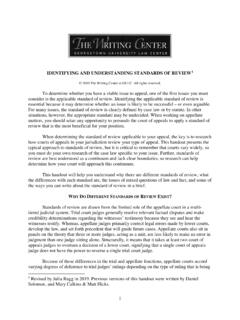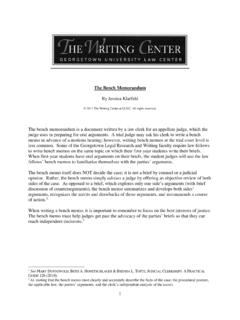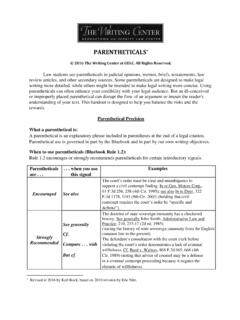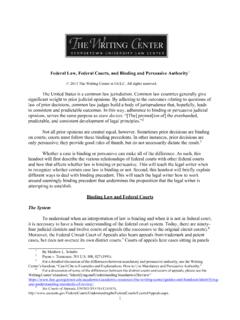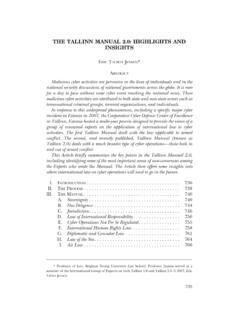Transcription of A Guide to Reading, Interpreting and Applying Statutes
1 1 A Guide TO reading , Interpreting AND Applying STATUTES1 2017 The Writing Center at GULC. All Rights Reserved. Whether you are working in a law firm, a government agency, or a public interest organization, it is likely that you will be required to analyze and interpret Statutes . Understanding the tools and techniques of statutory interpretation will help you to understand the possible implications a statute may have on your client s interests. Although the task of statutory interpretation can be quite nuanced and complicated, this handout will provide you with a few handy tools that will help you to discern the meaning of a statute, even when the terms of the statute seem unclear or ambiguous.
2 In particular, this handout will address what to do before you begin Interpreting a statute (Part I), tools of statutory interpretation (Part II), and theories of statutory interpretation (Part III) that can help inform which tools of interpretation you employ. I. Preliminary Steps There are three important preliminary steps you should take before attempting to interpret a given statute: 1. Read the statute. The primary language of the statute should always serve as the starting point for any inquiry into its To properly understand and interpret a statute, you must read the text closely, keeping in mind that your initial understanding of the text may not be the only plausible interpretation of the statute or even the correct 2.
3 Understand your client s goals. Make sure that you have a firm grasp of your client s goals and the underlying facts of your client s legal problem so that you will be able to determine which Statutes are relevant to your case. 3. Confirm the statute is still good law. Be sure to Shepardize or KeyCite the statute to determine: (a) whether the statute or parts of the statute have been repealed or 1 The original handout was written in 2006 by Katharine Clark and Matthew Connolly consulting WILLIAM N. ESKRIDGE, JR., PHILIP P. FRICKEY, & ELIZABETH GARRETT, CASES AND MATERIALS ON LEGISLATION: Statutes AND THE CREATION OF PUBLIC POLICY (3d.)
4 Ed. 2001). The handout was revised in 2017 by Suraj Kumar and Taylor Beech. 2 ESKRIDGE, supra note 1, at 819. 3 CHRISTOPHER G. WREN AND JILL ROBINSON WREN, THE LEGAL RESEARCH MANUAL: A GAME PLAN FOR LEGAL RESEARCH AND ANALYSIS (2d. ed. 1986) (hereinafter WREN & WREN ). 2 otherwise invalidated; (b) whether the statute has been amended; and (c) whether there are any court decisions that can Guide your analysis of the statute. II. Tools of Statutory Interpretation Although some Statutes appear simple and straightforward at first glance, you may find, upon further examination, that the terms of the statute are ambiguous or do not directly address your legal issue.
5 There are several tools that can help you to determine the meaning of an ambiguous statute or to choose between multiple plausible interpretations of the same statute. These tools fall into the following four categories: (A) the text of the statute; (B) legal interpretations of the statute; (C) the context and structure of the statute; and (D) the purpose of the statute. Additionally, certain techniques of statutory construction have been used so often that they have become formalized into canons of construction. While these canons may not be particularly useful for discerning the meaning of a statute, many courts find them persuasive, and you may use these canons to justify and provide support for a particular interpretation of a statute.
6 Be aware, however, that for each canon that supports your interpretation, there is often an opposite canon that can be used to defeat your interpretation or support an alternative interpretation of the statute in Additionally, your audience may find some canons more persuasive than others. Each of the sections below addresses the tools of statutory interpretation and identifies relevant canons of construction5 that you can use to justify and support your interpretations. A. Statutory Text a. Statutory Definitions Many Statutes contain a definitions section that sets forth and defines the key terms used in the statute.
7 You might find these definitions either in the section of the statute you are analyzing or in one of the first sections of the entire act. Sometimes these specific terms are codified as definitions for a chapter or title of the relevant statute, meaning that they are intended to apply to the entire chapter or title (unless otherwise specified). These definitions are important because they suggest that legislatures intended for a term to have a specific meaning that might differ in important ways from its common usage. 4 See Karl N. Llewellyn, Remarks on the Theory of Appellate Decision and the Rules or Canons About How Statutes Are to be Construed, 3 VAND.
8 L. REV. 395, 401-406 (1950). 5 See generally ANTONIN SCALIA & BRYAN A. GARNER, reading LAW (2012). 3 b. Plain Meaning i. Ordinary or Reasonable Understanding Courts generally assume that the words of a statute mean what an ordinary or reasonable person would understand them to Moreover, some courts adhere to the principle that if the words of a statute are clear and unambiguous, the court need not inquire any further into the meaning of the Thus, you can often begin by looking at the ordinary or reasonable understanding of a statute s text based on your own experience and understanding of language and grammar.
9 Ii. Dictionary Definitions Dictionaries can also be helpful in Interpreting the meaning of statutory language. It will likely be more effective to compare and contrast definitions from multiple dictionaries to obtain a broader consensus on the meaning of words. Analyzing interpretations from multiple sources will help you to reduce the risk of choosing an interpretation that may have been approved by one source but rejected by many If you are asked to interpret a statute that was enacted a long time ago, you might consider digging up dictionary definitions (as well as other sources such as encyclopedias) from the time period in which the statute was Be aware however, that if a statute deals with a technical or specialized subject ( , ERISA, tax, telecommunications, etc.)
10 , the words in the statute may have meanings that differ from their ordinary usage. In such circumstances, courts may interpret the text dealing with a technical or specialized subject in a manner consistent with the way those words are used in the relevant industry or community. iii. Common Law Definitions Similar to words that have a technical or an industry-specific meaning, some statutory words can have a meaning in common law that is widely understood and accepted. In such cases, courts will adopt the common law For example, the Supreme Court has noted that extortion is a common law word, and it has interpreted that term by reference to its meaning at common c.
